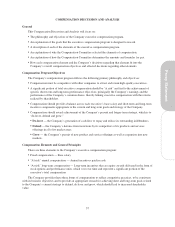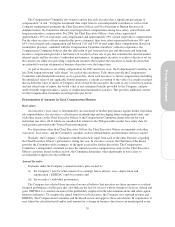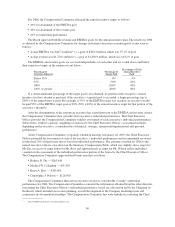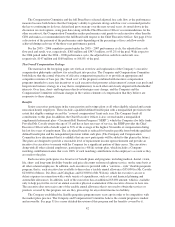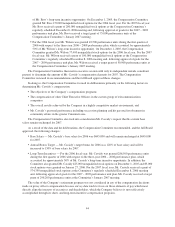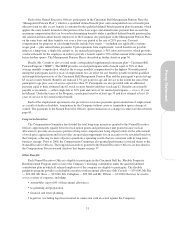Cincinnati Bell 2006 Annual Report Download - page 57
Download and view the complete annual report
Please find page 57 of the 2006 Cincinnati Bell annual report below. You can navigate through the pages in the report by either clicking on the pages listed below, or by using the keyword search tool below to find specific information within the annual report.
Miscellaneous Items
Stock Ownership Guidelines
The Compensation Committee recognizes that executive stock ownership is an important means of aligning
the interests of the Company’s executives with those of its shareholders. To that end, the Compensation
Committee has established the following stock ownership guidelines:
Chief Executive Officer — 3 times base salary
Other named executive officers — 1.5 times base salary
Since the personal situation of each executive may vary, the Compensation Committee has not set a specific
period of time in which the ownership level must be achieved, but does expect each executive to make
measurable progress on a year-over-year basis as evidenced by the number of shares owned multiplied by the fair
market value of the Company’s stock. Aside from the Company’s actual performance from one year to the next,
the price of the Company’s stock price may vary due to the general condition of the general economy, which may
also be reflected in the trend of the stock market. Therefore, the Compensation Committee may measure an
executive’s progress more on the basis of the year-over-year increase in the number of shares owned than the
actual market value in relation to the executive’s ownership goal. For purposes of measuring ownership, only
shares owned outright by the executive (including shares owned by the executive’s spouse and/or dependent
children, and shares owned through the Company’s savings plan and/or deferred compensation plan) are
included. Shares represented by vested stock options or any other form of equity for which some condition
remains to be completed before the executive has earned a right to and actually received the shares (except as
may have been electively deferred to a future date) are not included in determining the executive’s level of
ownership.
As of February 28, 2007, Mr. Cassidy owned shares valued at approximately 125% of his ownership target
of three times his base salary. In addition, as of February 28, 2007, Mr. Dir, who joined the Company in July
2005, has achieved approximately 45% of his ownership goal; Mr. Wilson has achieved approximately 46% of
his ownership goal and Mr. Ross has achieved approximately 95% of his ownership goal. The ownership target
changes as the executive’s base salary is adjusted.
Severance/Change-in-Control Payments and Benefits
The severance and change-in-control payments and benefits described in more detail beginning on page 60
were important to ensure the retention of Mr. Cassidy and the other named executive officers at the time they
were promoted to their present positions and to their continued retention. The payments and benefits are
comparable to those that their predecessors in office were receiving and are reasonable and consistent with
market practice. Market survey data indicates that the level of payments and benefits is comparable to that
provided by other companies to employees at a similar level. Providing employment agreements to these key
executives provides several advantages to the Company. These agreements give the Company the flexibility to
make changes in key executive positions, if such change is determined by the Company or the Board to be in the
best interests of the Company. Under the provisions of the employment agreements, the Company and the Board
have the flexibility to make such a change with or without a showing of cause and the provisions of the
agreements minimize the potential for litigation by establishing separation terms in advance and requiring that
any dispute be resolved through an arbitration process. Additionally, the Company considers the employment
agreements to be important in situations involving a possible change-in-control because they provide the
executives with sufficient compensation and clarity of terms, should a change in control occur. Thus, the
executives are able to devote their full attention to fairly evaluate the potential transaction and its benefit to the
Company and its shareholders rather than being distracted by the transaction’s possible effect on their personal
employment situation. In addition, other employment termination scenarios covered by the agreements include
disability, death, termination by the Company for cause, and the executive’s voluntary termination.
Mr. Callaghan’s employment agreement included a provision, that was amended into his agreement on
February 3, 2003, whereby he was entitled to a payment equal to two times the sum of his base salary plus target
bonus should he elect to terminate his employment with the Company by December 31, 2006. In addition,
Mr. Callaghan was entitled to continue his medical, dental, vision and life insurance at active employee
45
Proxy Statement




